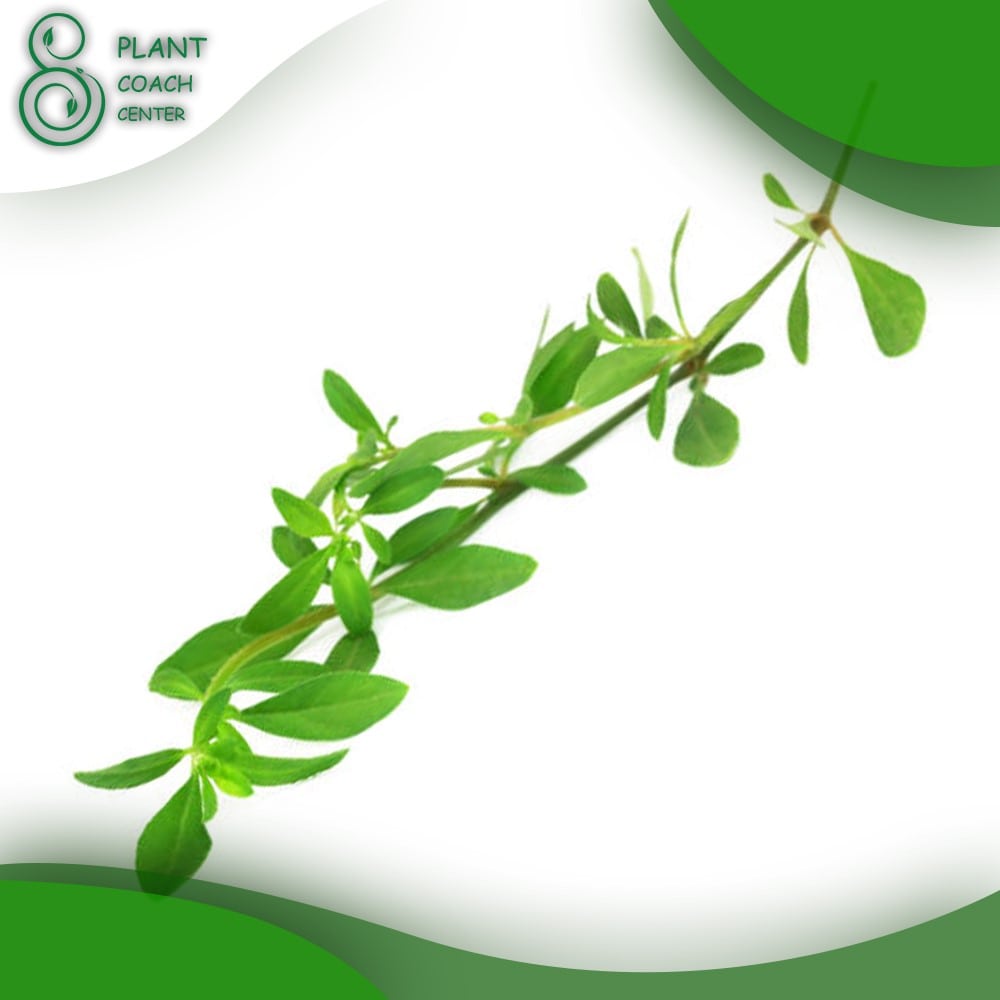When to Plant Thyme
When it comes to planting thyme, timing is crucial for optimal growth and flavor. In this comprehensive guide, we’ll delve into the various factors that influence the ideal planting time for thyme. Whether you’re a beginner or an experienced gardener, this article, brought to you by Plant Coach Center, will provide valuable insights to help you grow thriving thyme plants.
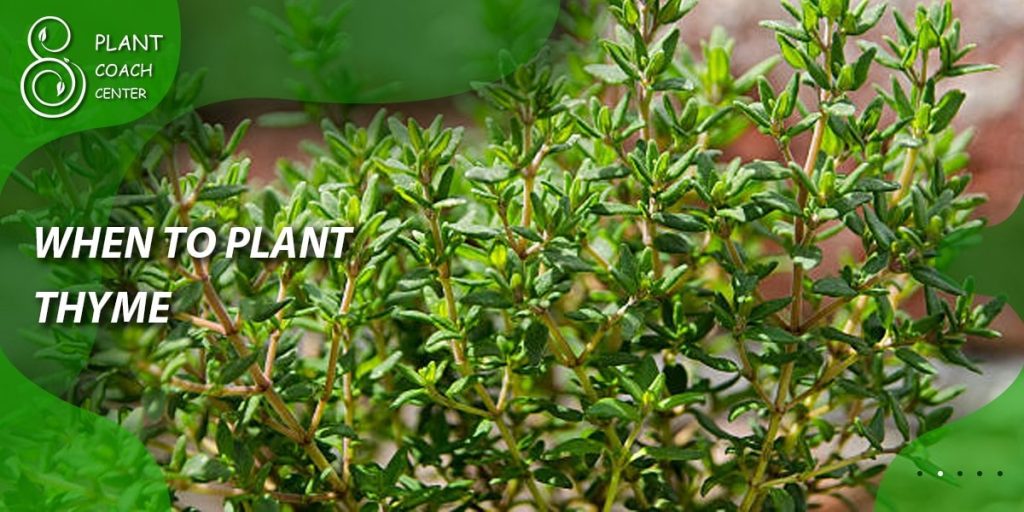
Understanding Thyme Planting Requirements
Thyme, a versatile herb with aromatic leaves, thrives under specific conditions. Understanding its planting requirements sets the foundation for successful cultivation.
- Climate and Hardiness Zones for Thyme
– Thyme is well-suited to regions with a Mediterranean climate, but it can be grown in various climates.
– Check the hardiness zone of your location to determine if thyme can withstand the local conditions.
- Soil Conditions and pH Level for Thyme
– Thyme prefers well-draining soil with a pH level between 6.0 and 8.0.
– Amend heavy or compacted soil with organic matter to improve its drainage and structure.
- Sunlight and Light Requirements for Thyme
– Thyme thrives in full sun, requiring at least six hours of direct sunlight each day.
– Ensure your planting location provides ample light for the herb to flourish.
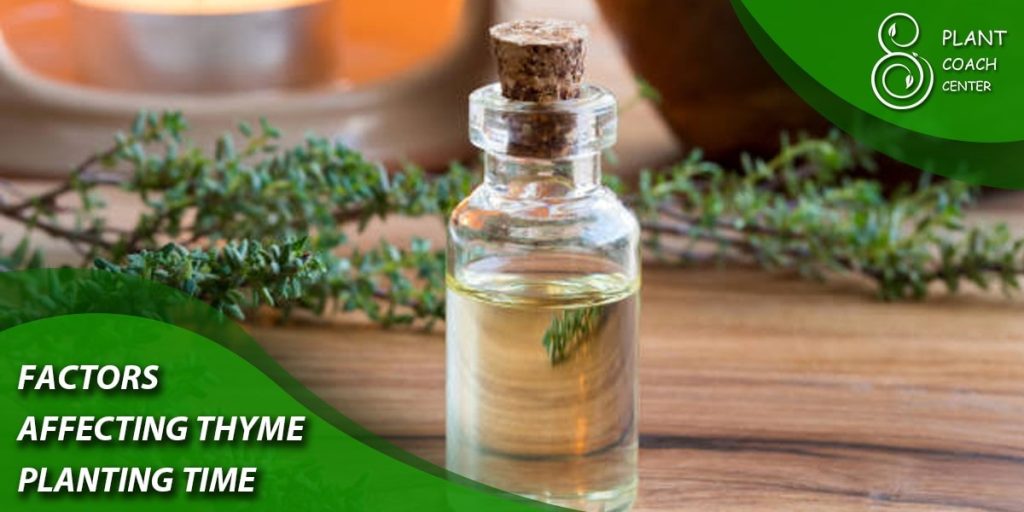
Factors Affecting Thyme Planting Time
Timing is crucial when it comes to planting thyme. Several factors influence the best time to sow or transplant thyme seedlings.
- Seasonal Considerations
- Spring Planting:
– Spring is a popular time for planting thyme, as it allows the herb to establish roots before the summer heat.
– Wait until the danger of frost has passed and the soil has warmed up.
- Summer Planting:
– In cooler climates, summer planting can be ideal, as thyme thrives in warm temperatures.
– Ensure adequate soil moisture during the establishment phase.
- Fall Planting:
– In mild climates, fall planting is suitable as thyme can establish before winter.
– Plant early enough to allow sufficient root development.
- Winter Planting (in milder climates):
– In regions with mild winters, thyme can be planted throughout the winter.
– Protect young plants from frost and provide adequate moisture.
- Regional Variations and Microclimates
– Consider regional variations and microclimates that may affect the best time to plant thyme.
– Consult local gardening resources or experienced gardeners for insights specific to your area.
- Thyme Varieties and Their Specific Planting Needs
– Different thyme varieties may have specific planting requirements.
– Research individual varieties to determine the optimal planting time for each.
Assessing Soil Readiness for Thyme Planting
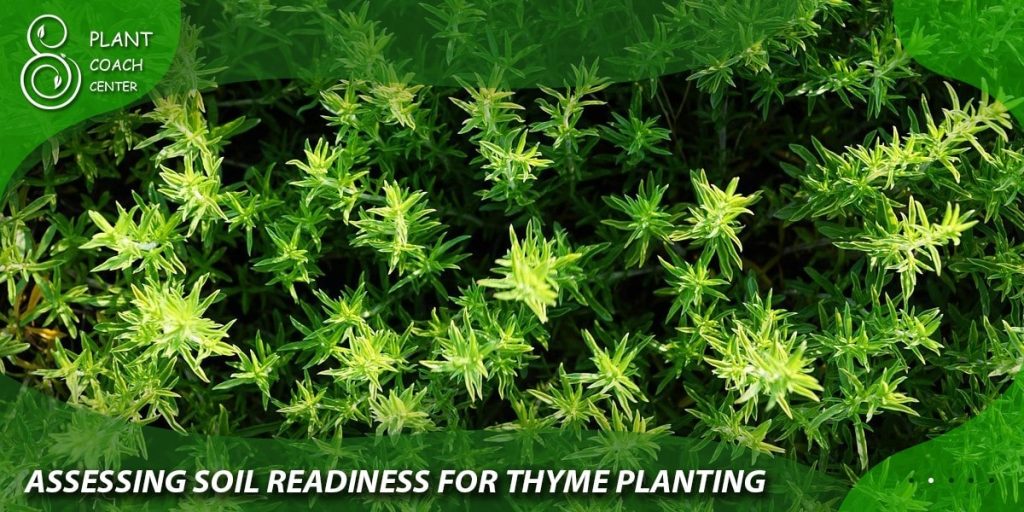
Before planting thyme, it’s essential to assess soil conditions to ensure a favorable environment for the herb’s growth.
- Testing Soil Temperature
– Thyme thrives when the soil temperature reaches around 60°F (15.5°C) or higher.
– Use a soil thermometer to gauge the temperature before planting.
- Soil Moisture and Drainage Considerations
– Thyme requires well-draining soil to prevent root rot and other moisture-related issues.
– Check soil moisture levels to ensure it’s not too wet or dry before planting.
- Preparing the Soil for Thyme Planting
– Prepare the planting area by removing weeds, loosening the soil, and incorporating organic matter.
– This improves soil structure, drainage, and nutrient availability for thyme plants.
Starting Thyme from Seeds or Transplants
Deciding whether to start thyme from seeds or use transplants is an important consideration. Each method has its advantages and specific guidelines.
- Seed Starting Guidelines
- Germination Time and Conditions
– Thyme seeds typically germinate within 7 to 14 days under optimal conditions.
– Provide consistent moisture and warmth (around 70°F/21°C) to encourage germination.
- Indoor Seed Starting
– Start thyme seeds indoors 6 to 8 weeks before the last expected frost date in your region.
– Use seed trays or pots filled with a sterile seed-starting mix.
– Sow seeds lightly and cover them with a thin layer of soil.
– Maintain a warm and well-lit environment for seedlings to thrive.
- Outdoor Seed Starting
– In regions with mild winters, thyme seeds can be directly sown in the garden in early spring.
– Prepare the soil by removing debris and loosening it to create a fine seedbed.
– Sow the seeds at the recommended depth and spacing, and keep the soil consistently moist until germination occurs.
- Using Transplants or Nursery-Bought Thyme
- Selecting Healthy Transplants
– When choosing nursery-bought thyme plants, select healthy specimens with vibrant foliage and no signs of disease or pests.
– Inspect the root system to ensure it’s well-developed and not root-bound.
- Transplanting Techniques and Timing
– Transplant thyme seedlings outdoors after the last frost date, once the soil has warmed up.
– Dig a hole slightly larger than the root ball and gently place the seedling, ensuring it’s at the same depth as it was in the container.
– Backfill the hole and firm the soil around the plant.
– Water thoroughly after transplanting to settle the soil around the roots.
Best Practices for Planting Thyme
To give your thyme plants the best start possible, follow these best practices when planting them in the garden.
- Choosing the Right Planting Location
– Select a location that receives full sun and has well-draining soil.
– Consider planting thyme near other herbs or vegetables that have similar sunlight and soil requirements.
- Proper Spacing and Planting Depth
– Space thyme plants 8 to 12 inches (20 to 30 cm) apart to allow for proper air circulation and growth.
– Plant thyme at the same depth it was growing in the container or seed tray.
- Watering and Irrigation Considerations
– Thyme prefers moderate moisture levels, so water deeply when the top inch of soil feels dry.
– Avoid overwatering, as thyme is susceptible to root rot.
- Mulching and Weed Control
– Apply a layer of organic mulch around thyme plants to suppress weeds and retain soil moisture.
– Keep the mulch a few inches away from the stems to prevent moisture-related issues.
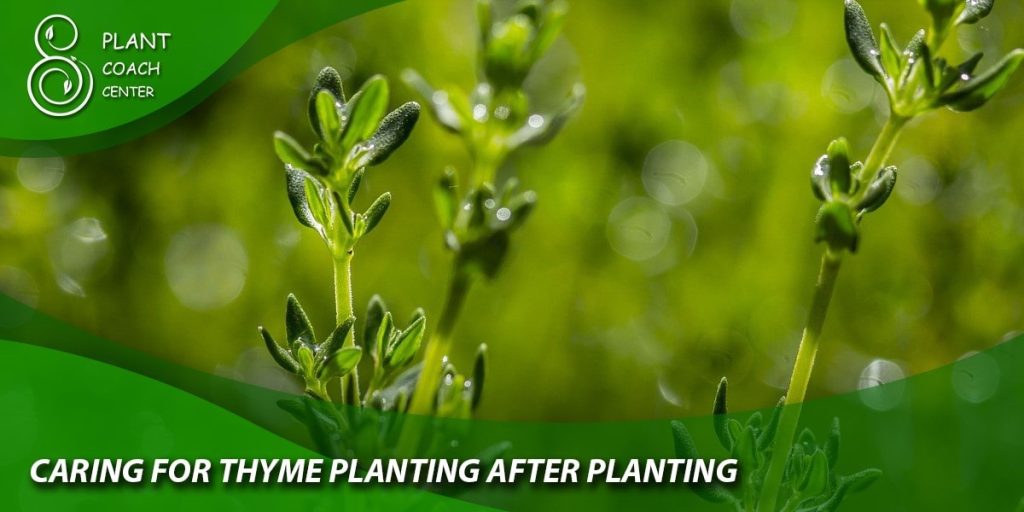
Caring for Thyme Plants After Planting
Proper care is essential for the healthy growth and development of thyme plants. Follow these guidelines to ensure their well-being.
- Thinning and Pruning Thyme Seedlings
– Once thyme seedlings have established, thin them to maintain proper spacing and airflow.
– Prune regularly to encourage bushier growth and prevent legginess.
- Fertilizing Thyme Plants
– Thyme is a low-maintenance herb that doesn’t require heavy fertilization.
– Apply a balanced, slow-release organic fertilizer during the growing season, following the package instructions.
- Pest and Disease Management
– Monitor thyme plants for common pests like aphids, spider mites, and thrips.
– Use natural pest control methods or organic insecticides if necessary.
– Keep an eye out for signs of diseases such as powdery mildew or root rot, and promptly address any issues.
- Supporting Thyme Plants (staking or trellising)
– Depending on the thyme variety and growth habit, some plants may benefit from staking or trellising for support.
– Use stakes or trellises to keep the plants upright and prevent them from sprawling on the ground.
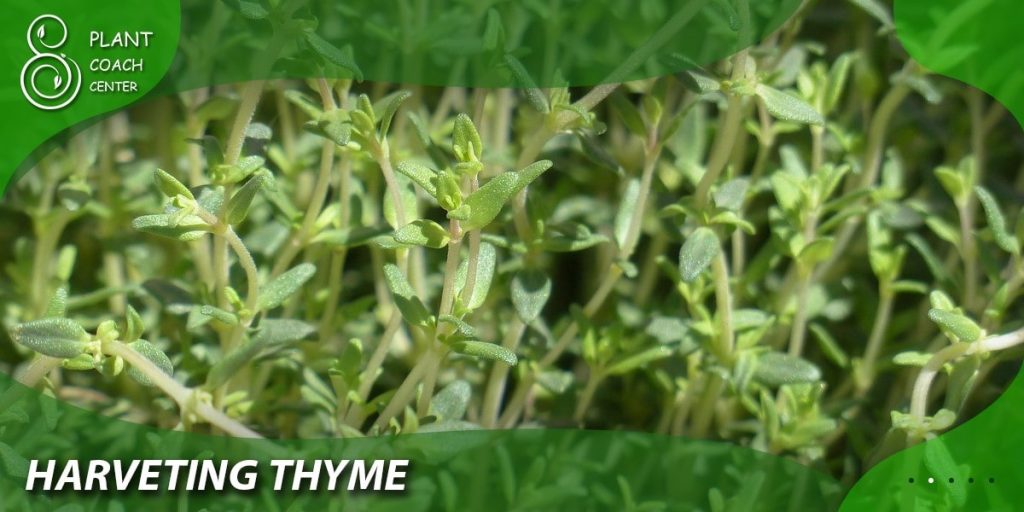
Harvesting Thyme
Harvesting thyme at the right time ensures optimal flavor and quality. Follow these steps for a successful harvest.
- Determining the Right Time to Harvest
– Thyme can be harvested throughout the growing season, but the flavor is most concentrated just before flowering.
– Wait until the plants are mature and have developed a good amount of foliage.
- Techniques for Harvesting Thyme Leaves
– Use scissors or pruning shears to cut thyme stems just above a set of leaves.
– Harvest from different parts of the plant to encourage bushier growth.
- Preserving and Storing Thyme
– Rinse harvested thyme in cool water and pat it dry with a paper towel.
– Air-dry the stems in a well-ventilated area, away from direct sunlight.
– Once dry, remove the leaves from the stems and store them in an airtight container in a cool, dark place.
Troubleshooting Common Thyme Planting Problems
Despite your best efforts, thyme plants may encounter certain issues. Here are some common problems and their solutions.
- Slow or Failed Germination
– Ensure the seeds are fresh and of good quality.
– Provide optimal conditions for germination, including proper moisture, temperature, and light.
- Yellowing or Wilting Leaves
– Check for overwatering or underwatering issues and adjust the watering accordingly.
– Monitor for nutrient deficiencies and provide appropriate fertilization.
- Pests and Diseases Affecting Thyme
– Identify the specific pests or diseases affecting your thyme plants.
– Use appropriate organic pest control methods or consult a professional if necessary.
- Nutrient Deficiencies and Imbalances
– Conduct a soil test to identify any nutrient deficiencies or imbalances.
– Amend the soil with organic fertilizers or supplements based on the test results.
Conclusion
successful thyme cultivation relies on understanding the ideal planting time and providing proper care throughout its growth. By following these guidelines, you can enjoy a bountiful harvest of flavorful thyme. Stay tuned for the final part of our comprehensive guide, where we’ll provide additional tips and insights for successful thyme planting and cultivation.
Remember, for more expert guidance on plant care and gardening tips, visit Plant Coach Center at [plantcoachcenter.com] (https://www.plantcoachcenter.com).


